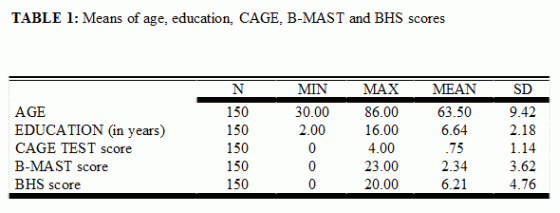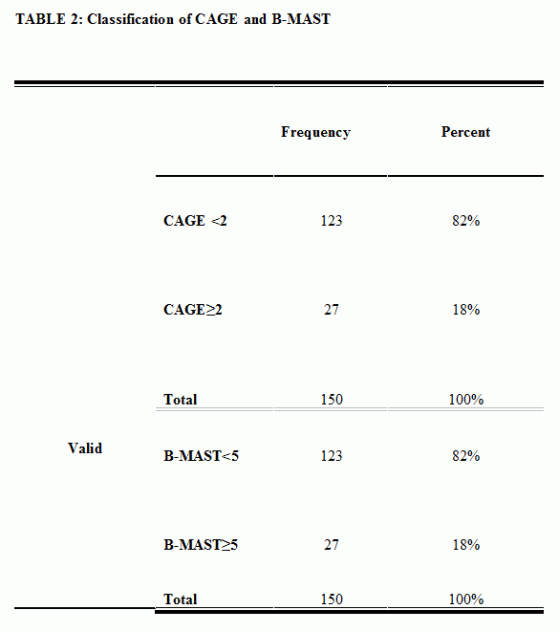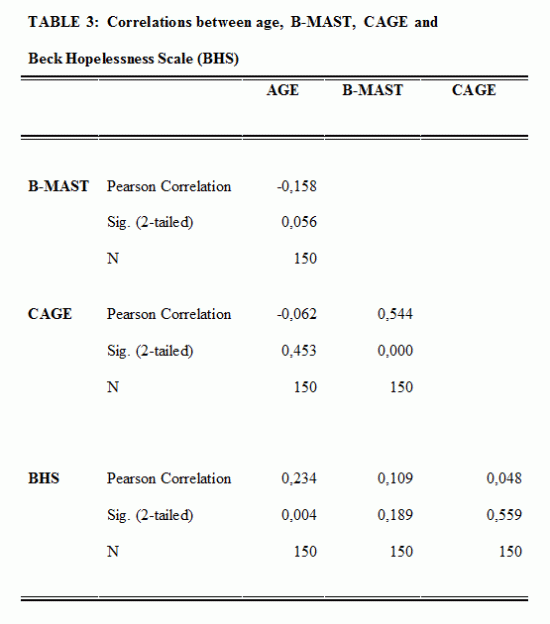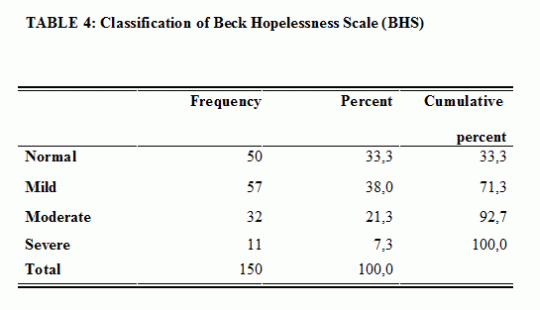|
|||||
|
|||||
Alcoholism and hopelessness in male patients with diagnosed lung cancer
T. KOSTARAS*, A. TSELEBIS*, D. BRATIS*, D. STAMOULI*, A. BOTSIS**, M. ANAGNOSTOPOULOU*, A. CHRISTODOULAKI*, A. PACHI*, A. KARKANIAS*, G. MOUSSAS*
*Psychiatric Sector, "Sotiria" General Hospital of Chest Diseases, Athens, Greece
**University Research Institute of Mental Health, Athens, Greece
Abstract
The relation between alcohol consumption and cancer development danger has been investigated in several studies, which suggest a particular connection between alcoholism and development of lung cancer. The objective was to investigate the existence of alcohol abuse-dependence, hopelessness and lung cancer in male patients. All participants were examined with the Brief Michigan Alcoholism Screening Test, the Cage Test and the Beck Hopelessness Scale. Student ’s t-test, ANOVA test and Pearson’s correlation were used for the evaluation of data. A percentage of 18% of patients with lung cancer answered positively to the questionnaires on alcohol abuse-dependence problems. No correlation was observed between the BHS score and the alcohol abuse-dependence. Our findings confirm the existence of the increased frequency of alcohol abuse /dependence among male patients with diagnosed lung cancer. Furthermore, it appears that this comorbidity has a higher influence at younger individuals, a finding which is in accordance with other relevant studies. Encephalos 2011, 48(3):103-107.
Key words: Alcoholism, hopelessness, lung cancer.
Background
According to the World Health Organization (WHO), the alcohol abuse/dependency disorders have a prevalence of 1–5% in the developing and developed countries, including Greece1. Nevertheless, it is proved that the alcohol abuse/dependency increases the danger of mortality up to 50%, independently of the alcohol quantity consumed2.
At the same time, the disorders which are related to the alcohol consumption are described by the WHO as an enormous public health problem, which, according to recent estimations, correspond to 1,4% of global disease burden3.
Regarding Greece, relative studies indicate that alcohol consumption is very widespread in young persons, especially men4-5.
The relation between alcohol consumption and cancer development danger has been investigated in several studies, which suggest a particular connection between alcoholism and development of lung cancer6-7, especially when alcoholism coexists with tobacco use8-9.
Furthermore, several studies in Greece indicated the existence of depressive symptomatology among patients with respiratory diseases10. However, the studies that are attempted to investigate the hopelessness among lung cancer patients are limited.
The aim of this study is to investigate the existence of alcohol abuse/dependency in male patients with lung cancer and to register the hopelessness of these patients.
Methods
The specimen of the study consisted of all the male patients who were hospitalized and diagnosed for lung cancer (independently of the type classification or staging) in the pulmonary departments of a chest diseases hospital, for a three months period.
For the estimation of alcohol abuse/dependency all the participants were called to complete the Cage (Cut down, Annoyed, Guilty, Eye–Opener) Test and the Brief Michigan Alcoholism Screening Test (B-MAST). Correspondingly, the Beck Hopelessness Scale (BHS) was used in order to assess hopelessness.
The Cage Test uncovers alcoholism and includes four items answered by yes or no. Two or more positive answers suggest alcohol abuse/dependence11.
The B-MAST includes ten items and it is considered positive when the total score is >512.
The reliability of the above instruments for the screening of the covered alcoholism is comparable of an external criterion, such as clinical diagnosis12-13. For the purposes of the present study, a Greek adaptation of the instruments was used14.
The BHS is constituted of twenty items and was designed to measure three particular dimensions of hopelessness: (a) thoughts about the future, (b) lack of motivations and (c) expectations about future15. Total score >=9 suggests the presence of a significant degree of hopelessness and possible manifestation of self – harm behaviour16. A Greek adaptation of this scale was used17.
Residents and psychologists acquainted their use administered the above instruments. The needed time for the completion was no more than fifteen minutes.
Finally, we recorded the demographics of participants (age, education level and family status).
All the subjects gave their informed consent for participating in the study.
Student’s t-test, ANOVA test and Pearson’s correlation were used for the evaluation of data. Two-tailed statistical significance was set at p<=0.05. The computations were carried out with SPSS for Windows, version 15.0 statistical software.
Results
The sample included one hundred and fifty hospitalized male patients, diagnosed for lung cancer. The mean age was 63.5 years (SD: 9.43, table 1) and the mean duration of education was 6.65 years (SD: 2.19, table 1). As for the family status, 84% were married, 4.7% were single, 8% were divorced and 3.3% were widowed.
Out of the 150 participants only 18 patients (12%) had knowledge of the exact diagnosis, while the majority of the patients (88%) were ignorant of the cancer diagnosis.
The mean scores were 0.75 (SD: 1.15), 2.34 (SD: 3.63) and 6.21 (SD: 4.77) for the Cage Test, the B-MAST and the BHS, respectively (table 1). A positive score in Cage Test (positive answers >=2) was noted for 18% of all patients (table 2), while the same percentage of positive scores (>5) was noted in the B-MAST (table 2).


The family status of the subjects did not seem to differentiate the score in any of the given instruments (ANOVA test p>0.05). Though, patients with positive scores in the Cage Test and in the B-MAST were younger compared to patients with negative scores (60.04 ± 9.53 vs 64.26 ± 9.27, t test p>0.05 and 58.48 ± 8.67 vs 64.44 ± 9.30, t-test p<0.05). The age factor presented a strong positive correlation with the BHS score (Pearson Correlation Sig. 2 tailed, p<0.01, r = 0.24, table 3).

The Cage Test, the B-MAST and the BHS scores did not presented correlation with the level of education, regarding the total sample (Pearson Correlation Sig. 2 tailed, p>0.05). Additionally, no correlation was observed between Cage Test, B-MAST and BHS scores (Pearson Correlation Sig. 2 tailed, p>0.05).
The knowledge or the ignorance of the diagnosis did not differentiate the score in BHS (6.1 ± 4.6 vs 7.2 ± 5.7, t test p>0.05). However, a significant percentage of 28.6% of the patients indicated moderate to severe symptoms of hopelessness (table 4). On the other hand, the subjects with severe hopelessness appeared with higher B-MAST scores compared to the other patients (6.89 ± 2.18 vs 2.14 ± 3.23 t test p<0.05).

Finally, a strong positive correlation was observed between the Cage Test and B-MAST scores (Pearson Correlation Sig. 2 tailed, p<0.01, r = 0.54, table 3).
Discussion
As it has already been pointed out, the frequency of alcohol abuse/dependence, regarding Greece, fluctuates between 1 to 5%1. However, in cases in which exists comorbidity, the frequency of alcohol abuse/dependence appears elevated18-19.
The findings of the present study confirm the existence of the increased frequency of alcohol abuse/dependence among male patients with diagnosed lung cancer. At the same time, it appears that this comorbidity has a higher influence at younger individuals, a finding which is in accordance with other relevant studies20-21.
Even though, no relation was found, regarding the total of our sample, between the alcohol abuse/dependence and the hopelessness, it seems that the patients who mentioned intense negative aspects and attitude about future, are those who, at the same time, appeared with increased frequency of alcoholism. However, this finding needs further investigation in order to interpret as an attempt of self-medicate or relief from the painful psychological symptoms that usually accompany the diagnosis of cancer22.
Additionally, the elevated hopelessness, which is observed among these patients, is compatible to the negative sentimental burden, which involves the lung cancer diagnosis23-24.
Furthermore, the fact that the levels of hopelessness do not differ between the two sub-groups of patients (those having knowledge of the diagnosis and those who are ignorant of it) is possibly relevant with the insecurity and suspicions or assumptions of those who are ignorant of their cancer diagnosis. Moreover, it is known that the “bad news” spreads in many indirect ways25.
REFERENCES